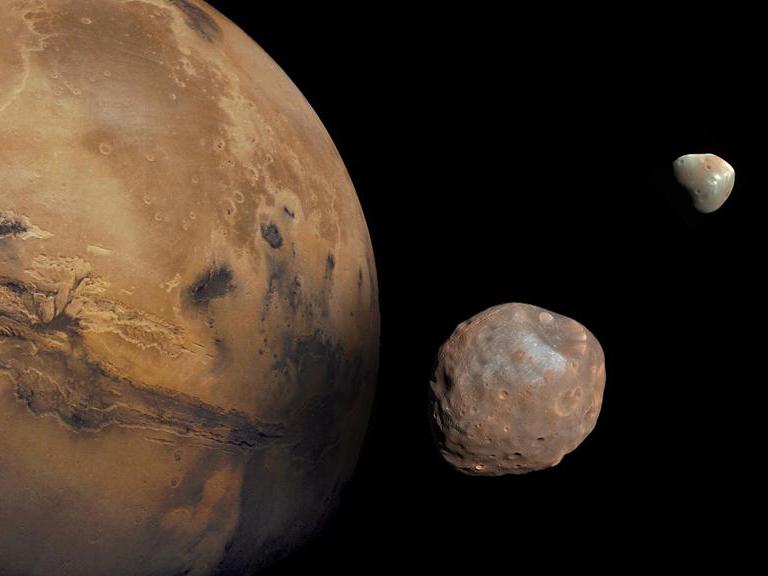Martian moon Phobos could be home to extinct alien life from an ancient lake, new Jaxa study suggests
The Martian Moons eXploration (MMX) probe may find evidence of this life from 2024 and return it to Earth in 2029

Your support helps us to tell the story
From reproductive rights to climate change to Big Tech, The Independent is on the ground when the story is developing. Whether it's investigating the financials of Elon Musk's pro-Trump PAC or producing our latest documentary, 'The A Word', which shines a light on the American women fighting for reproductive rights, we know how important it is to parse out the facts from the messaging.
At such a critical moment in US history, we need reporters on the ground. Your donation allows us to keep sending journalists to speak to both sides of the story.
The Independent is trusted by Americans across the entire political spectrum. And unlike many other quality news outlets, we choose not to lock Americans out of our reporting and analysis with paywalls. We believe quality journalism should be available to everyone, paid for by those who can afford it.
Your support makes all the difference.Mars’ largest moon Phobos may have evidence of ancient life that went extinct on the Red Planet, keeping it in pristine condition for billions of years.
Astronomers from the Japan Aerospace Exploration Agency (Jaxa) believe that numerous asteroid impacts that have hit Mars over time could have displaced material from the planet and delivered it to its moons.
Of the two moons Phobos, located only 9,377 kilometres from Mars compared to the more distant Deimos, it is likely to have collected more debris from its host planet.
The moon itself is not hospitable – lacking air, water, and a surface that is constantly subject to cosmic radiation that would kill any microorganisms – but would mean it is less likely that any extinct life from Mars that travelled there would have not been interrupted by other variables.
Both Phobos and Demios were found to have been caused when mars and another planet-sized object collided in a violent impact.
Compared to our own moon, however, Phobos and Deimos are tiny - only 7.5 miles and 14 miles across, respectively.
The dead biosignatures on Phobos, which Jaxa have called ‘SHIGAI’ (Sterilized and Harshly Irradiated Genes, and Ancient Imprints, as well as Japanese for ‘dead remains’) could include sterilized microorganisms and potential DNA fragments. Scientists Ryuki Hyodo and Tomohiro Usui, in an article summary about the work, describe the moon as an “ideal natural laboratory”.
The Jezero crater on Mars is thought to be a likely harbour of extinct life, as it is believed to be the site of an ancient lake. Scientists think that its possible biosignatures observed in samples from the crater could also be on the surface on Mars – something they will know with greater accuracy when the Martian Moons eXploration (MMX) space probe launches in 2024.
“If Martian life once existed and was widespread elsewhere on Mars, the chance that its dead remains (defined as "SHIGAI" in the paper because Phobos surface is inhospitable due to radiation) exist also on Phobos is, in my opinion, relatively high. This is because numerous small asteroidal impacts on Mars eject Martian surface material, and the ejecta is relatively easily transferred to Phobos”, Dr Hyodo told The Independent.
The Martian Moons eXploration (MMX) probe plans to collect a sample of over 10 grams from the Phobos surface and return it to Earth in 2029, where detection of a “fingerprint” of Martian life could be found from the study of the material.
There is also the possibility that Mars never had life at all, but even if that were true then these missions remain vital in understanding why such a close planetary neighbour has such an absence of activity compared to the Earth. It could also be the case, Dr Hyodo said, that dead remains on the surface of Phobos or Demios could have gradually decomposed over time.
A potential explanation for an absence of life on Mars could be that it formed under a completely different environment from that of Earth, such as being more distant from the Sun and suffering from a colder atmosphere. The early surface temperature or surface composition could have also been unfavourable for a life-form to emerge, Dr Hyodo continued. “We still do not know what is the ‘key’ conditions to have life-form emerged”, he added.
“In my opinion, of all the chances for finding life-as-we-know-it in the Solar System, the surfaces of Mars and Phobos are our best bet”, said Jaxa’s James O’Donoghue, who described the moons as a potential “time-capsule of ancient Mars”
“After we’ve checked there, our next best hopes would be at the icy moons of Jupiter and Saturn, but those will be very difficult to check relative to the Mars system, owing to their substantial distances and radiation environment.”
The research, ‘Searching for life on Mars and its moons’, was published in Science.
Join our commenting forum
Join thought-provoking conversations, follow other Independent readers and see their replies
Comments